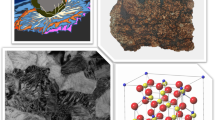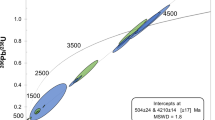Abstract
The material characteristics of lunar materials are discussed as indicators of shock metamorphism. As lunar materials are subjected to both impact shock modification due to energetic particles formed at locations of collisionless plasma shocks in cosmic space, it is necessary to identify specific features of each process. All types of lunar glasses formed by various impacts under high pressure (∼ 90 GPa) are found as impact glass, ropy glass, agglutinates and brecciated rocks. The agglutinates and iron particles are identified from X-ray diffraction measurements. Fine-grained lunar materials, including the agglutinates and breccias bonded by crystals and glasses due to impact shocks, contain hydrogen and helium from the energetic particles of collisionless shocks. Lunar shocked minerals of plagioclase and silica show anomalous compositions and densities. The shock metamorphism shows evidence for two major impact processes on evolved and primordial lunar surfaces: (1) shocked silica phases with minor Al contents formed from plagioclase-rich primordial crusts of the Moon, and (2) shocked quartz formed by silica-rich target rocks, especially on evolved parts of the Moon. Silica subjected to both impact and energetic particle modification can grow to coarse-grained normal crystals by long existence in vapor plume under high-temperature or after gradual high-temperature evolution, with the result that original effects of the impact process cannot be distinguished.
Similar content being viewed by others
References
Bansal BM, Gast PW, Hubbard NJ, Nyquist LE, Rhodes JM, Shih CY, Wiesmann H (1973) Lunar rock types. In: Lunar science IV. Lunar and Planetary Institute, Houston, pp 48–50
Dence MR, Douglas JAV, Plant AG, Traill RJ (1970) Petrology mineralogy and deformation of Apollo 11 samples. In: Proc. Apollo 11 Lunar Sci. Conf., Houston, pp 315–340
French B (1968) Shock metamorphism as a geological process. In: Shock metamorphism of natural materials. Mono Book Corp., Baltimore, pp 1–17
Heiken GH, McKay DS, Fruland RM (1973) Apollo 16 soils: grain size analysis and petrography. In: Proc. Lunar Sci. Conf. 4th. Houston, pp 251–265
Hintenberger H, Weber HW (1973) Trapped rare gases in lunar fines and breccias. In: Proc. Lunar Sci. Conf. 4th. Houston, pp 2003–2019
Hutcheon ID, Macdougall JD (1976) Particle track studies. In: Electron microscopy in mineralogy. Springer-Verlag, pp 537–542
Hutcheon ID, Price PB (1972) Plutonium-244 fission tracks: evidence in a lunar rock 3.95 billion years old. Science 176:909
Miura Y (1988) Amorphous impact materials in planetary science. Lunar Planet. Sci. Conf. 19th. Houston, pp 792–793
Miura Y (1989) Application of remote-SIMS for glass and trace-element compositions of lunar soils. LPI Technical Report 90-2. Houston, pp 52–53
Miura Y (1991a) Evidence for shock wave effect of meteoritic impact. Shock waves 1:35
Miura Y (1991b) Formation processes of shocked quartz by impact metamorphism. Lunar and Planet. Sci. Conf. 21st, Houston. Lunar and Planetary Institute, Houston, pp 905–906
Miura Y, Kato T (1989) Different densities of diaplectic plagioclase crystals among meteorites, lunar rocks and terrestrial impact craters. Lunar and Planet. Sci. 20th. Lunar and Planetary Institute, Houston, pp 703–704
Miura Y, Kato T (1991) Shock metamorphism of achondrites, lunar samples, and lunar meteorites. Sympo. Antarctic Meteorites 16th. National Institute of Polar Research, Tokyo, pp 17–19
Miura Y, Kato T (1992) Shock metamorphism on the Moon. Celestial Mechanics and Dynamical Astronomy 54:1
Miura Y, Noma Y, Iancu OG (1993) New occurrence of shocked graphite aggregates at Barringer crater. Meteoritics 28:402
Miura Y, Takayama K, Kato T, Kawashima N, Yamori A (1992) Shock metamorphism in artificial impact craters. In: Takayama K (ed) Shock waves Proc. 18th Intl. Symp. Shock Waves, held at Sendai, Japan 21–26 July 1991. Springer-Verlag, Heidelberg, pp 403–407.
Nagao K, Miura Y, Koh Y (1989) Noble gas isotopic compositions of nine chondrites from Antarctica. Symp. Antarctic Meteorites 14th. National Institute of Polar Research, Tokyo, pp 104–105
Sagdeev RZ, Kennel CF (1991) Collisionless shock waves. Scientific American 4:40
Stöffler D (1971) Coesite and stishovite in shocked crystalline rocks. J Geophysical Research 76:5474
Taylor LA (1988) Generation of native Fe in lunar solids. In: Proc. Space 88 (USA). pp 67–77
Taylor LA (1990) Hydrogen, helium and other solar-wind components in lunar soil: abundances and predictions. Proc. Space 90 (USA), pp 68–77
Tidman DA, Krall NA (1971) Shock waves in collisionless plasmas. Wiley-Interscience, New York, p 350
Author information
Authors and Affiliations
Additional information
This article was processed using Springer-Verlag TEX Shock Waves macro package 1.0 and the AMS fonts, developed by the American Mathematical Society.
Rights and permissions
About this article
Cite this article
Miura, Y., Graham, R.A. Shock metamorphism on the surface of the Moon. Shock Waves 3, 293–298 (1994). https://doi.org/10.1007/BF01415827
Received:
Accepted:
Issue Date:
DOI: https://doi.org/10.1007/BF01415827




